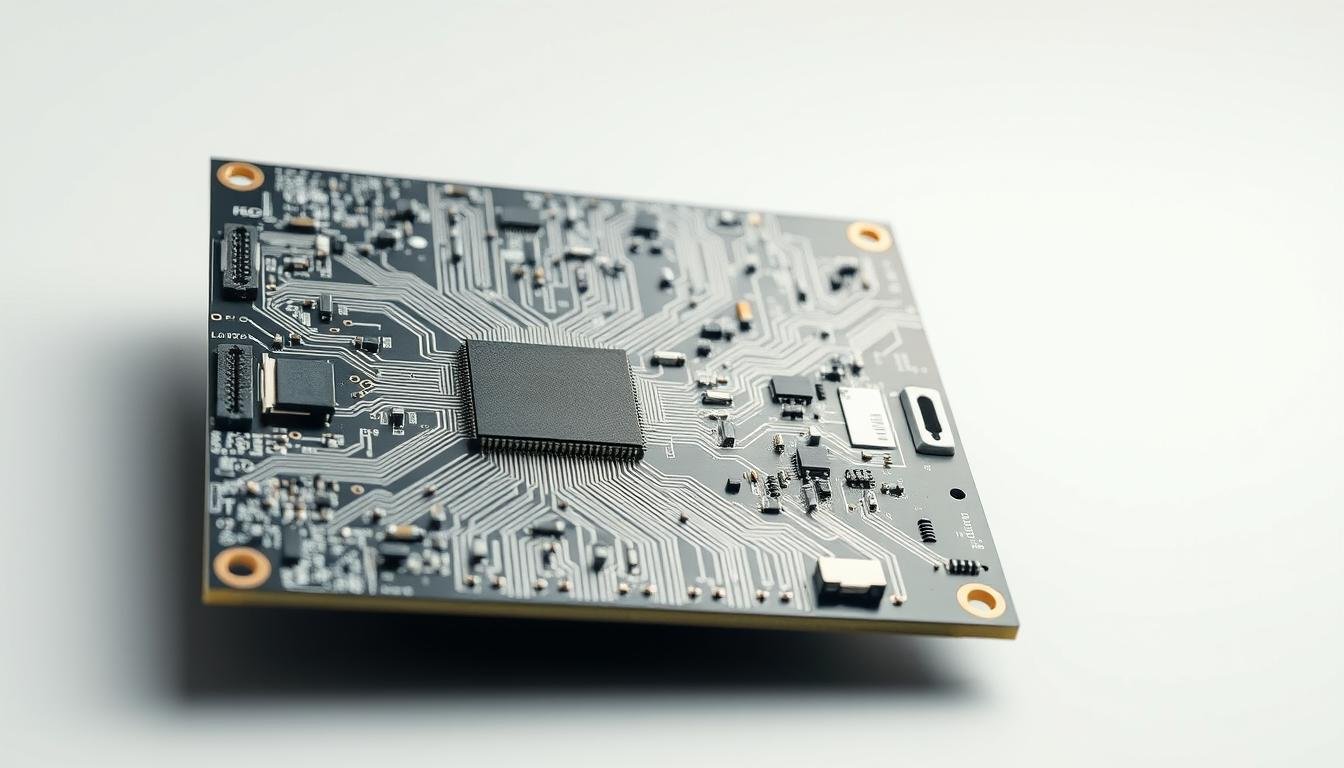Many electronics manufacturers assume their supplier’s unit price tells the full financial story. But what if hidden fees quietly erase 15-30% of your projected margins? We’ve seen companies lose profitability not through poor design or weak sales, but through overlooked expenses baked into global supply chains.
Landed cost analysis reveals the true price of bringing components to your production line. Tariffs, freight insurance, and warehousing fees often slip through traditional accounting methods. These silent budget killers distort pricing strategies and erode competitive edges.
Our team specializes in mapping the complete journey of PCBAs from foreign factories to U.S. facilities. One recent client discovered 22% unaccounted costs – including unexpected port congestion surcharges and currency conversion penalties. These findings transformed their supplier negotiations and inventory planning.
Key Takeaways
- Component pricing represents only 60-75% of final expenses
- Tariff classifications can alter duty rates by 300%
- Supply chain delays create hidden storage and financing costs
- Currency fluctuations impact payment timelines
- Compliance failures trigger costly customs holds
Mastering these variables separates thriving manufacturers from those struggling with phantom costs. Let’s explore how to convert financial blind spots into measurable advantages.
Overview of Landed Cost in Global Trade
Global supply chains hide critical financial variables behind supplier invoices. Forty-three percent of procurement managers admit to underestimating international logistics expenses, according to recent industry surveys. This gap between quoted prices and actual spending creates unpredictable profit erosion.
Definition and Core Components
We define landed cost as every dollar spent moving electronics from overseas factories to your assembly line. Essential elements include:
- Base product pricing
- Ocean/air freight charges
- Customs duties & import taxes
- Warehousing & handling fees
Currency conversion spreads and compliance certifications often slip through initial estimates. A $10 circuit board might carry $4 in hidden fees before reaching your facility.
Impact on Profit Margins and Business Strategy
Accurate cost tracking transforms pricing models. Companies using granular landed cost data achieve 18% higher margins than competitors relying on surface-level estimates. One client renegotiated shipping contracts after discovering port fees consumed 9% of their component budget.
Strategic decisions emerge from this clarity. Bulk ordering becomes viable when storage costs are quantified. Supplier comparisons gain depth with true expense benchmarks. Profitability shifts from guesswork to calculated outcomes.
How to Calculate the Total Landed Cost of Your Imported PCBAs
Smart manufacturers know component pricing forms just one variable in their financial equation. We’ve developed a structured framework to quantify every expense layer – transforming vague estimates into precise figures.
Breaking Down the Basic Equation
Our proven formula captures all financial variables:
- Base product price – Supplier’s quoted unit cost
- Transport allocation – Freight charges divided by shipment quantity
- Regulatory fees – Duties, taxes, and compliance certifications
- Contingency buffer – Storage delays, currency fluctuations, insurance
Consider a Shanghai-to-LA shipment of 100 PCBAs at $50/unit. Freight costs $1,000 for 25% capacity use. With 5% duty rates:
$50 + (($1,000×25%)/100) + (5%×$50) = $55/unit
Real-World Calculation Examples
Actual scenarios reveal hidden expenses. When customs holds added $300 in delays:
- Three-day storage at $100/day
- $3/unit contingency cost
- Final landed cost per PCBA: $58
We help clients track these variables through customized dashboards. One manufacturer reduced surprise costs by 17% using our freight allocation models. “Now we see cost drivers before they impact margins,” their procurement director noted.
Understanding Shipping, Customs, and Additional Fees

Global electronics procurement teams often discover shipping complexities only after invoices arrive. Forty-two percent of logistics managers report unexpected charges that weren’t factored into initial budgets. These expenses accumulate at every touchpoint between factories and assembly lines.
Freight, Handling, and Packaging Charges
Transportation costs extend beyond basic container rates. Consider these key elements:
| Fee Category | Typical Range | Cost Drivers |
|---|---|---|
| Ocean Freight | $1,800-$4,500/container | Fuel surcharges, peak season rates |
| Terminal Handling | $120-$300/shipment | Port congestion levels |
| Protective Packaging | $8-$25/unit | ESD-safe materials, moisture control |
Air shipments often double costs compared to sea transport but prevent production delays. One client saved 14% by switching to consolidated freight after we analyzed their packaging efficiency.
Customs Duties, Taxes, and Temporary Costs
Tariff classifications determine duty rates for PCBAs. Using correct HTS codes:
- 6.2% standard rate vs 0% under USMCA
- Brokerage fees: $75-$250 per entry
- Harbor maintenance fee: 0.125% of cargo value
“Our Chicago client avoided $18,000 in demurrage charges through real-time customs tracking,” our logistics lead noted. Temporary storage fees at ports can exceed $150/day during inspections – a critical factor in just-in-time manufacturing.
Risk, Insurance, and Overhead Considerations

Global electronics buyers often face a critical choice: pay for protection now or risk devastating losses later. One damaged shipment can erase profits from an entire production run. We help clients navigate this balance through strategic coverage planning and overhead optimization.
Managing Insurance and Risk Coverage
Marine cargo insurance remains the frontline defense against transit disasters. Policies typically cost 0.1-0.5% of shipment value – a small price for protecting high-value PCBAs. Our team recently prevented $92,000 in losses for a client when typhoon-damaged components were fully reimbursed.
Quality assurance forms the second layer of risk management. Incoming inspections and compliance checks catch defects before assembly lines stall. “We reduced warranty claims by 19% after implementing their testing protocols,” shared a medical device manufacturer.
Overhead Expenses and Compliance Costs
Behind every shipment lies hidden operational investments:
- Purchasing team salaries averaging $75,000-$110,000 annually
- Supplier audit travel costs ($2,500-$7,500 per overseas visit)
- Currency exchange fees consuming 1-3% of transaction values
Compliance demands constant attention. A recent supply chain study showed companies spending $15,000-$40,000 annually on environmental certifications and safety documentation. Proper planning turns these expenses into competitive advantages rather than budget drains.
Safety stock requirements add another layer. Overseas lead times often necessitate 20-35% buffer inventory. Our models help clients minimize carrying costs while maintaining production continuity – a balance that protects both cash flow and customer commitments.
Tools and Strategies for Accurate Cost Estimation
Modern supply chains demand precision tools to navigate fluctuating expenses. We equip teams with methodologies that convert guesswork into measurable projections, ensuring financial predictability across international shipments.
Leveraging Freightos Calculators for Live Quotes
Digital platforms revolutionize expense tracking. Freightos provides real-time rate comparisons through two specialized tools:
- Freight Calculator: Input shipment dimensions or container specs for instant quotes
- Duty Estimator: Generate customs fee projections using HTS codes and trade lanes
These tools help avoid budget surprises. A recent analysis showed 23% variance between initial quotes and final invoices without proper tracking. Automated systems reduce this gap to under 5%.
| Fee Type | Manual Approach | Automated Tools |
|---|---|---|
| Freight Rates | 3-5 day quote process | Instant comparisons |
| Duty Calculations | Risk of HTS misclassification | Code validation features |
| Currency Fees | Separate FX tracking | Integrated rate alerts |
Implementing Data-Driven Decision Making
Strategic procurement requires continuous learning. We help clients establish three core practices:
- Track actual vs. estimated costs monthly
- Benchmark supplier performance metrics
- Update calculation templates quarterly
One manufacturer reduced duty overpayments by 14% after implementing our variance analysis framework. “The system flags discrepancies before payments clear,” their logistics manager noted.
Historical data reveals patterns. Teams can anticipate peak season surcharges or port congestion trends. This foresight strengthens negotiations and inventory planning – critical factors in maintaining profit margins.
Managing and Reducing Landed Costs for Better Profitability
Unseen charges in cross-border transactions often undermine carefully planned budgets. We help manufacturers convert cost control into strategic leverage through targeted optimizations.
Strategic Partnerships and Logistics Efficiency
Regional supplier evaluations yield dual benefits: reduced transport distances and improved lead times. Our team analyzes total ownership costs across geographic options, often uncovering 12-18% savings through localized sourcing.
Carrier rate negotiations become powerful when supported by shipment data. Consolidated freight strategies and alternative routing options frequently cut logistics expenses by 20% without sacrificing reliability.
Smart Inventory Flow and Facility Placement
Just-in-time delivery models minimize storage fees while maintaining production continuity. One client reduced warehousing costs by 31% through our demand forecasting adjustments and safety stock recalibrations.
Facility location decisions directly impact inland transport expenses. Positioning distribution centers near major ports cut one manufacturer’s drayage costs by $27,000 annually. Real-time tracking systems now help them avoid detention charges entirely.
These operational refinements create cascading benefits. Improved cash flow, stronger supplier relationships, and predictable profit margins emerge when landed costs become measurable variables rather than hidden threats.
FAQ
What’s included in a total landed cost calculation?
How do customs duties affect imported PCBAs?
Why include risk coverage in landed cost analysis?
Can freight calculators improve cost accuracy?
What strategies reduce landed costs long-term?
How often should we recalculate landed costs?
About The Author
Elena Tang
Hi, I’m Elena Tang, founder of ESPCBA. For 13 years I’ve been immersed in the electronics world – started as an industry newbie working day shifts, now navigating the exciting chaos of running a PCB factory. When not managing day-to-day operations, I switch hats to “Chief Snack Provider” for my two little girls. Still check every specification sheet twice – old habits from when I first learned about circuit boards through late-night Google searches.
